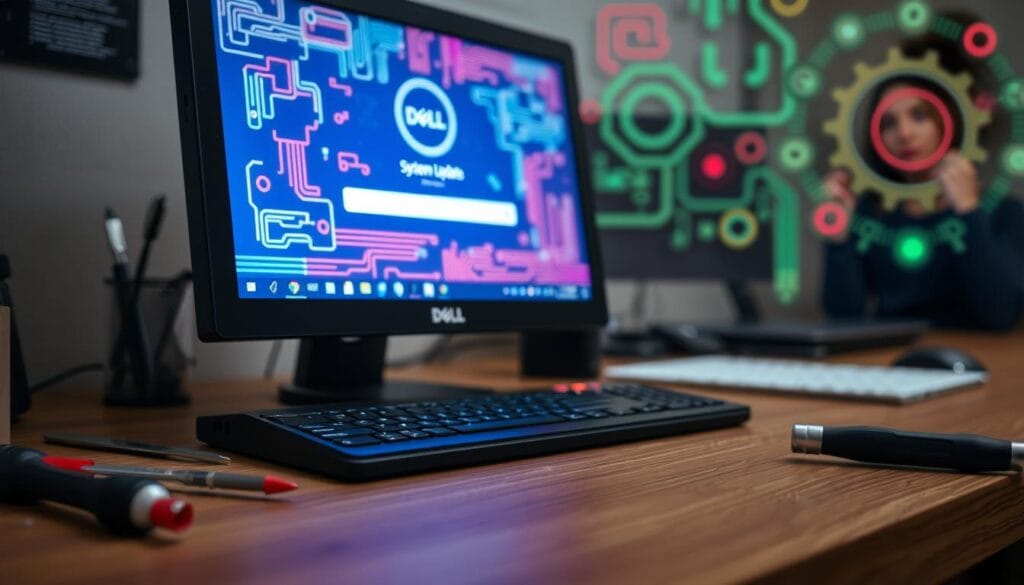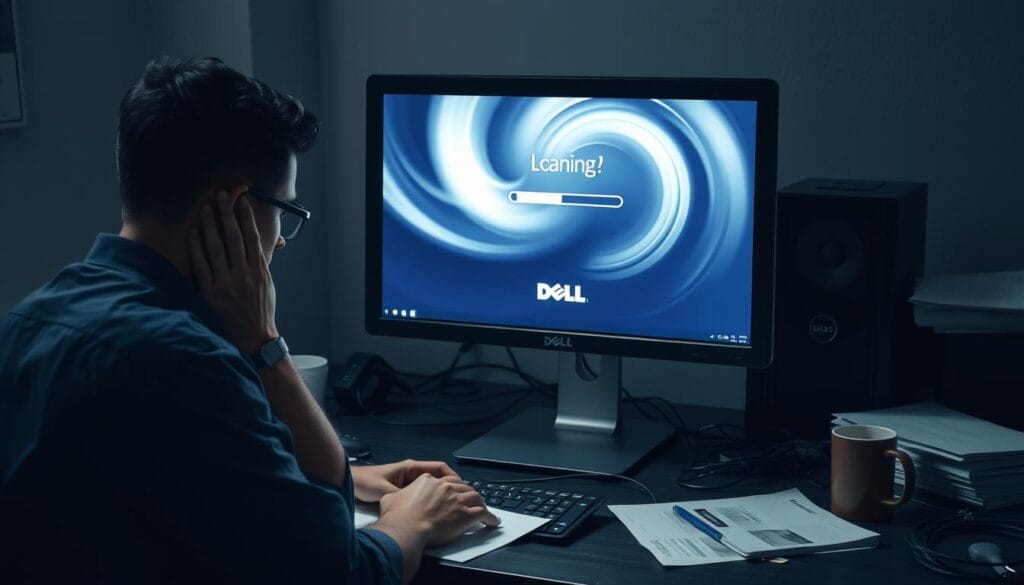Table of Contents
We’ve all been there: you’re in the middle of an important task, and your Dell PC suddenly reboots during an update. It’s more than just an inconvenience—it’s a moment of utter frustration. Your project is halted, your workflow disrupted, and the fear of data loss looms large. When your Dell PC rebooted during the update, it’s crucial to address this issue swiftly.

This article will guide you step-by-step to troubleshoot and fix Dell PC reboot problems, ensuring you can get back to what matters most without the constant worry of an unexpected reboot. Let’s dive into understanding the common causes and finding effective solutions to get your Dell PC running smoothly again.
Key Takeaways
- Understand the common causes behind your Dell PC rebooting during updates.
- Learn initial steps to diagnose the reboot issue effectively.
- Gain practical troubleshooting tips to fix Dell PC reboot problem.
- Find out how to prevent future reboot issues during updates.
- Discover advanced techniques for tackling persistent Dell PC update problems.
Understanding Why Your Dell PC is Rebooting During an Update
It’s frustrating when your Dell PC restarts during an update. Knowing why this happens is key to fixing the problem. We’ll look at common causes and how updates affect your system. This will help you solve the issue when your Dell PC won’t update right.
Common Causes of Dell PC Update Issues
There are many reasons why your Dell PC might have update problems. Knowing these can help you find and fix the issues:
- Software Conflicts: When different apps don’t get along, updates can fail.
- Corrupted Files: Bad or missing files during updates can make your PC restart.
- Inadequate System Resources: Not enough memory or storage can stop updates.
The Impact of Updates on System Performance
Updates are important for keeping your Dell PC running well and safely. But, if updates go wrong, it can slow down your PC. Fixing update errors quickly helps your PC run better, stay safe, and makes using it easier.
Initial Steps to Diagnose the Reboot Problem
When your Dell PC reboots during an update, it’s crucial to start a thorough diagnosis. These first steps will help you find and fix the main issues.
Checking Error Messages
First, look at any error messages shown during the reboot. These messages often give important clues about the problem. Look for specific codes or descriptions that can help you fix the update issue.
Reviewing Update Logs
Then, check the update logs to see the installation steps. These logs show where the update might have gone wrong. Looking at these logs is a key part of finding the reboot problem.
Identifying Specific Update Failures
Lastly, find out which updates didn’t install right. This is crucial for fixing the update problems. Identify any bad updates and fix them to make future updates smoother.
| Step | Action | Purpose |
|---|---|---|
| 1 | Check Error Messages | Identify initial causes of reboot |
| 2 | Review Update Logs | Track the update process and locate failures |
| 3 | Identify Specific Update Failures | Pinpoint and resolve problematic updates |
Fixing Dell PC Rebooted During the Update
If your Dell PC rebooted during an update, it can be frustrating and disrupt your work. Here are some practical solutions to help you fix the Dell PC update reboot loop and prevent it from happening again.
- Restart Your Computer – A simple restart can often solve the Dell PC update reboot loop. This action may allow the update to complete successfully.
- Run Windows Update Troubleshooter – This built-in tool can help identify and resolve common update issues. Navigate to Settings, select Update & Security, and click on Troubleshoot to find the relevant tool.
- Check for Disk Space – Make sure your system has enough free space for the update. You can free up space by deleting unnecessary files or using the Disk Cleanup utility.
- Update Drivers – Outdated drivers can cause update interruptions. Visit Dell’s official website to download and install the latest drivers for your model.
- Disable Automatic Restart – Temporarily disabling automatic restarts can help you troubleshoot Dell PC update issues without interference. Go to Control Panel > System > Advanced system settings, then click on Settings under Startup and Recovery to turn off automatic restarts.
- Perform a Clean Boot – This process can help isolate software conflicts that may be causing the reboot loop. Follow the steps listed in Microsoft’s guide on performing a clean boot.
If these steps do not resolve the issue, you may need to seek further assistance or consider more advanced troubleshooting techniques.
Effective Troubleshooting for Dell PC Update Issues
To solve Dell PC update problems, follow a few key steps. This ensures updates go smoothly. Troubleshooting these issues quickly saves time and keeps your system running well.

Running Windows Update Troubleshooter
Start by running the Windows Update Troubleshooter. This tool finds and fixes common update problems. To use it, go to Settings > Update & Security > Troubleshoot > Windows Update and follow the prompts.
Verifying Disk Space and System Health
Make sure your Dell PC has enough space for updates. Not enough space can stop updates. Check your storage under Settings > System > Storage. Also, run health checks to find any hardware problems that might be causing issues.
| Update Aspect | Steps to Fix |
|---|---|
| Disk Space | Clear temporary files, delete unnecessary applications, and move large files to external storage. |
| System Health | Run built-in diagnostics tools like Dell SupportAssist or Windows System File Checker (sfc /scannow). |
Ensuring Stable Internet Connection
A stable internet is key for updates. Slow or unstable internet can cause problems. Ensure your network is strong and steady. Try restarting your router and checking for ISP service outages to fix network issues.
By taking these steps, you can fix Dell PC update problems. This keeps your system current and secure.
Resolving Dell PC Stuck in Reboot Loop
When your Dell PC gets stuck in a reboot loop after an update, it can be frustrating and disruptive. But, there are effective strategies to fix this issue and prevent it from happening again. We will show you how to boot your system in Safe Mode and disable the automatic restart feature.
Safe Mode Boot
Booting your Dell PC in Safe Mode can help you bypass the reboot loop and access the system for further troubleshooting. Follow these instructions to boot in Safe Mode:
- Restart your Dell PC and press F8 repeatedly before the Windows logo appears.
- Select Safe Mode from the Advanced Boot Options menu.
- Once in Safe Mode, you can perform additional diagnostics or implement fixes to resolve the update issues.
Disabling Automatic Restart
Disabling the automatic restart feature prevents your Dell PC from continuously rebooting, giving you the time to troubleshoot the problem effectively. Here’s how to disable automatic restart:
- Right-click on This PC or My Computer and select Properties.
- Click on Advanced system settings and go to the Startup and Recovery section.
- Uncheck the box labeled Automatically restart under System Failure.
- Click OK to save the changes and close the dialogs.
By following these steps to boot in Safe Mode and disable automatic restart, you can fix the Dell PC update reboot loop issue. This will help stabilize your system and ensure smoother future updates.
Dealing with Dell PC Not Updating Properly
If your Dell PC is not updating properly, it can slow down your computer. It also makes it less secure. It’s important to fix this to keep your PC running smoothly.

- Restart Your PC: A simple restart can fix many update issues.
- Run Windows Update Troubleshooter: Microsoft has a tool to find and fix update problems. You can find it in Settings > Update & Security > Troubleshoot.
- Check Internet Connection: Make sure your internet is stable. Updates need a strong connection.
- Free Up Disk Space: Check if you have enough space on your disk. Not enough space can stop updates.
- Pause and Resume Updates: Sometimes, pausing and then starting updates again can help.
Here’s a detailed look at these troubleshooting steps:
| Troubleshooting Step | Description | Effectiveness |
|---|---|---|
| Restart Your PC | A simple reboot can often clear out minor glitches. | High |
| Windows Update Troubleshooter | Auto-detects and fixes common update-related issues. | Medium |
| Check Internet Connection | Ensures stable and continuous download of updates. | High |
| Free Up Disk Space | Checks and clears unnecessary files to create space for updates. | Medium |
| Pause and Resume Updates | Can trigger a reattempt at the download and installation process. | Low |
By trying these steps, you can fix Dell PC not updating properly. Keeping your system updated is key for its performance and security.
How to Prevent Dell PC from Rebooting During Update
To stop your Dell PC from rebooting during an update, you need to be proactive. Good Dell PC update management keeps your system running smoothly. Here’s how to do it.
Scheduling Updates Appropriately
Schedule updates when they won’t bother you. Late at night or during downtime is best. To set this up:
- Open the Windows Update settings.
- Select “Change active hours” to set when updates won’t interrupt you.
- Go to Update & Security, then Windows Update. Choose Advanced options and customize the update schedule.
Ensuring Regular Maintenance
Keeping your Dell PC in top shape is key for update management. Regular maintenance stops unexpected reboots. Here’s what to do:
- Run regular disk cleanup: Use Disk Cleanup to get rid of unnecessary files.
- Check system health: Use Windows Defender and System File Checker to keep your system in good shape.
- Install essential software updates: Keep drivers and software current to avoid update problems.
- Backup your data: Regular backups protect your files from loss during updates.
Addressing Dell PC Update Error Fix
Update errors on your Dell PC can be tough to handle. But, there are ways to fix these problems. You can try a Dell PC update error fix by using manual updates or System Restore.
Manual Update Installation
If auto updates don’t work, you might need to install updates manually. Here’s how:
- Go to the Dell support website and find the “Drivers & Downloads” section.
- Pick your PC model and find the updates you need.
- Download the updates and save them on your PC.
- Run the files and follow the instructions to install them.
This method ensures you get the latest updates. It helps your system run smoothly.
Using System Restore
System Restore is key when updates mess up your PC. It lets you go back to a previous state. Here’s how to do it:
- Open the Start menu and type “System Restore.”
- Choose “Create a restore point” from the search results.
- In System Properties, click on “System Restore.”
- Choose a restore point and start the process.
By picking a point before the update, you can fix problems caused by it. This way, you resolve Dell PC update issues.
These methods help solve common update problems. By updating drivers manually and using System Restore, you can keep your Dell PC running well. Being proactive with updates and System Restore can prevent future issues.
Advanced Dell PC Update Troubleshooting Techniques
When basic steps don’t work, it’s time for more advanced Dell PC update troubleshooting. You might need to update the BIOS or UEFI firmware or reinstall Windows. These steps can fix tough problems.
Updating BIOS/UEFI Firmware
Updating your Dell PC BIOS is key for better system stability and compatibility. Here’s how to do it smoothly:
- Visit the official Dell support website and find your PC model.
- Download the latest BIOS update package.
- Make sure your laptop is plugged in to avoid interruptions.
- Run the update tool and follow the instructions on the screen.
Keeping your BIOS or UEFI firmware up to date helps avoid unusual reboot problems.
Reinstalling Windows without Data Loss
If update issues persist, try reinstalling Windows without losing your data. Here’s how:
- Back up your important data to avoid losing anything.
- Get the Windows installation media from Microsoft’s official site.
- Run the installation media and choose “Upgrade” to keep your files.
- Follow the prompts to finish the installation.
Reinstalling Windows can fix deep software problems. It’s a key part of advanced Dell PC update troubleshooting.
Conclusion
Fixing your Dell PC’s reboot during an update is all about knowing the reasons and how updates affect your system. This guide has shown you how to find the problem and fix it. It covers everything you need to know for a successful update.
Start by checking your system and using tools like the Windows Update Troubleshooter. Make sure you have enough disk space and a stable internet connection. Also, updating your BIOS/UEFI firmware and reinstalling Windows without losing data are key steps.
It’s also important to plan updates well and check your system regularly. This keeps your PC running smoothly and updates go without a hitch. Use these tips to keep your system in great shape and avoid update problems.
FAQ
What are the common causes of Dell PC rebooting during an update?
Software conflicts, corrupted files, and not enough system resources are common causes. These problems can stop an update and cause the PC to reboot unexpectedly.
How can unexpected reboots during updates impact my Dell PC’s performance?
Reboots can lead to updates not finishing, losing data, and making the system unstable. It’s important to make sure updates finish without problems to keep your PC running well.
What initial steps should I take to diagnose a Dell PC reboot problem during updates?
First, check any error messages and look at the update logs. Also, find out which updates failed. These steps help find the main cause of the problem.
How can I fix a Dell PC that rebooted during an update?
Try restarting the update, checking for file corruption, and making sure there’s enough disk space. Follow these steps to fix the reboot loop.
What troubleshooting techniques can I use for Dell PC update issues?
Use the Windows Update Troubleshooter, check disk space and system health, and make sure your internet is stable. These steps can solve many update problems.
How do I resolve a Dell PC stuck in a reboot loop?
Try booting in Safe Mode or turning off automatic restart. This can break the loop and let you troubleshoot without interruptions.
What should I do if my Dell PC is not updating properly?
Check if updates are failing, manually install them if needed, and fix any problems quickly. This ensures updates work correctly.
How can I prevent future reboots during Dell PC updates?
Plan updates to avoid interruptions and do regular system checks. This reduces the chance of unexpected reboots during future updates.
What steps can I take to fix Dell PC update errors?
If auto-updates fail, manually install updates or use System Restore to go back to a previous state. These steps can fix update errors and make your system stable again.
What advanced troubleshooting techniques can I use for Dell PC update issues?
Update BIOS/UEFI firmware and reinstall Windows without losing data. These advanced methods can solve more serious update problems.
You can read more how-to guides by clicking here.
Or you can check out our apps on the Play Store:

